Sans-titre, 2017
13 bandes de PVC souple, peinture acrylique, marouflables,
80 x 120/480 cm chaque.
Vue de l’exposition à The Merchant House, Amsterdam, avec « Connie » 2017 et ” Douglas Cesar” 2017,
et la vidéo de l’ artiste Mary Sue « Revelations » , 2017.
Photos : Gert-Jan van Rooij
© Adagp, Paris
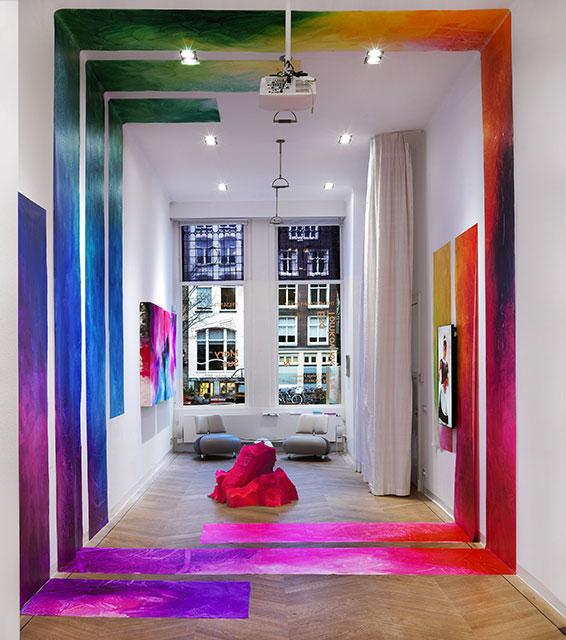

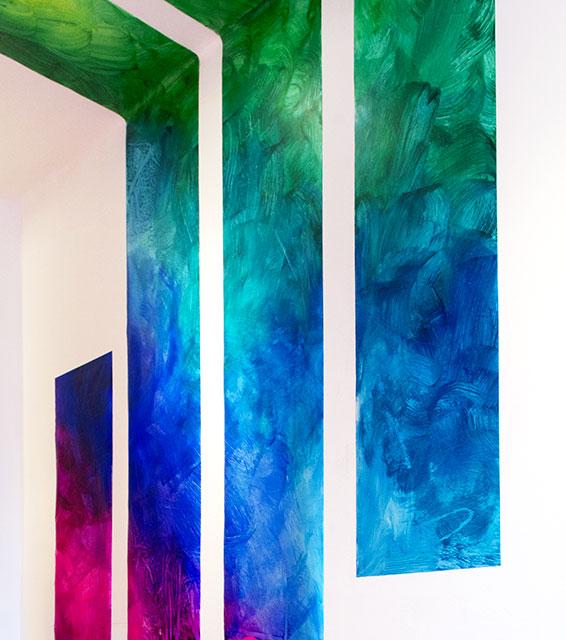
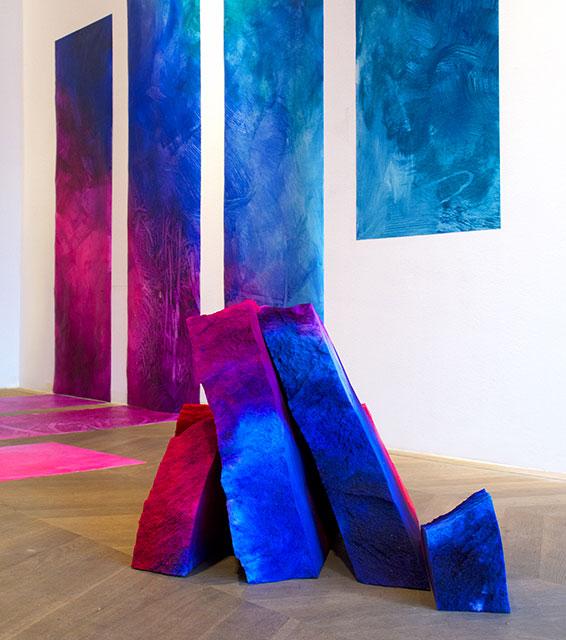

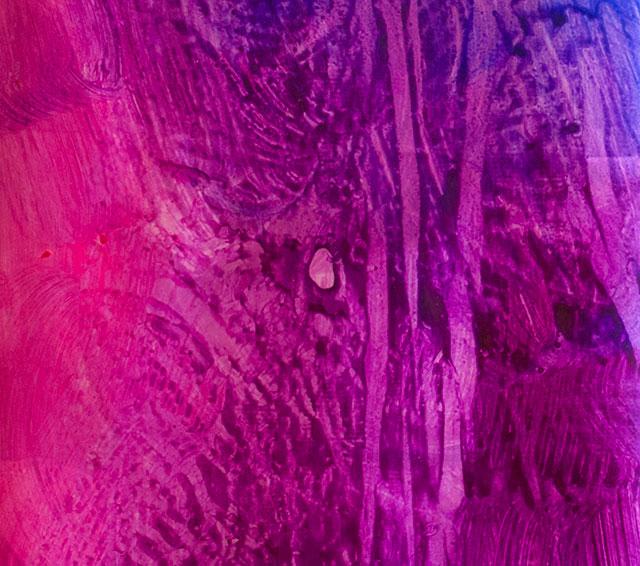
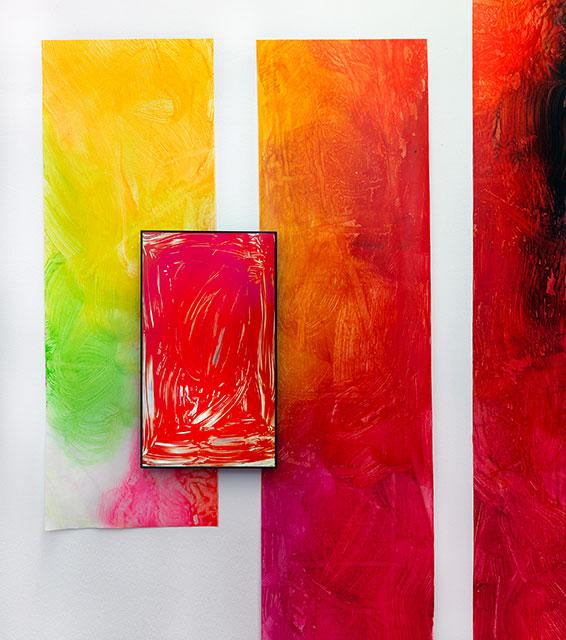

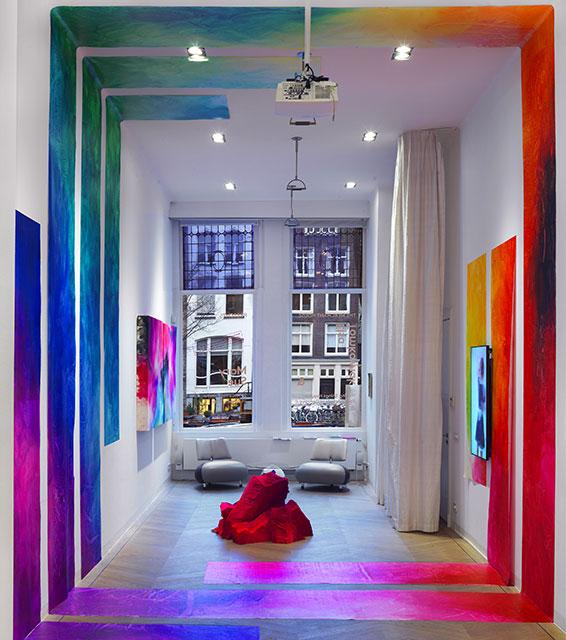
Meet Elsa Tomkowiak and Mary Sue
Marsha Plotnitsky, Founding Artistic Director of The Merchant House, on Making Things Happen: Young Artists in Dialogue II and the Playing Ground of TMH
Making Things Happen: Young Artists in Dialogue II opened during the Amsterdam Art Weekend 2017. To celebrate the promenade-style annual event, we asked Elsa Tomkowiak and Mary Sue to interpret The Merchant House, rich with the Golden Age symbolism particular to Amsterdam, as a contemporary public sphere. The trajectory of the canal house includes a major art-historical moment when Dutch private citizens supplanted the privileged religious and royal power patrons as connoisseurs and collectors of art. The collective experience of this given space in relation to the past and to TMH’s on-going problematic as a contemporary gallery continues through the exhibitions of the six young artists participating in the dialogue cycle. In researching Mary Sue and Tomkowiak’s work for the exhibition, I felt that their visual language was particularly suited to challenge the social aura and function associated with TMH.
How can a young artist confront the art world’s demands for the new? And in the wake of the 20th century’s multiple avant-gardes negotiate her place out and through the bourgeoning art scene?
Theirs is not the work that strikes one as radically new-media or urgently political. At first sight, the dialogue of Mary Sue and Elsa Tomkowiak impresses as an energetic and joyful—yet requiring patience to contemplate—reclaiming of the historical situation. Using both spoofing techniques and serious skills, they—Tomkowiak in painting and Mary Sue in video, sculpture, and photography—join forces to give the interior topography of TMH a provoking and provocative face-lift. In so doing, the artists also address individually, and emphatically with respect to their art, the underlying theme of TMH’s Making Things Happen: Young Artists in Dialogue cycle: how does a young artist inscribe herself in the history of her medium? For Mary Sue and Tomkowiak, the question refers to degrees of performance and a performative gesture in painting.
With a chance to exploit her adopted identity in a propitious situation, Mary Sue chose to deck herself out as a trim housemaid to burnish the hallowed fixtures of the Amsterdam burger residence. Bent on dramatic entry and irreverent transgressions of working with paint, Tomkowiak proposed an immersive path to open the space to the spirit of liberty and munificence. Devoted to their respective mediums and so stepping away from what is known as social practice, the artists are not suggesting a politically correct or corrective discourse. Allowing us to think the implications of their work into being, they trigger other perceptual levels of inquiry: Tomkowiak by the exploration of painted color—in the accretions of foam pounded with pigment and wall hangings—and Mary Sue by confronting us with her alter-ego personage, in a blue mini-dress, a white apron with a servant bow, and pink rubber gloves turning up everywhere. Mary Sue’s set includes posing in the baroque-framed mirror over the fireplace with a Fragonard-like ease, that is, after having wiped off her sweaty neck and breast with a yellow sponge. In the cases of both artists, every gesture and stroke of paint seems to register the desire to open up their respective artistic canons.
Tomkowiak the painter bluntly dares to remain at the level of abstraction, emphasizing its functional value through massive strokes of color on industrial materials (PVC, rough paper sheeting, and foam slabs) and generously offering her work as an installation backdrop to life—thus foregrounding the issues of the site that it inhabits. In a combative rejoinder, Mary Sue the performance artist shows herself faux-theatrically filmed in the confines of a flat screen, or caught in a repetitive action, or frozen in a static imagery reconstructing her every move and action as painting or sculpture. The mundane bang of a bucket or screech of a window wiper against glass from her videos add sound to the effectiveness of the show’s deployed constituents, including the work of her partner and our presence. The desire to remain within the space becomes so compelling that we seem to smell smells (the ad nauseam smell of common detergents) and to sense embodiment (of life in art or art in life, not quite clear which). The effect of the collaboration, which started with a difference of perspectives a few months earlier during their first meeting at TMH, is as a result complete.
French artists of the same generation and artistic formation, Tomkowiak and Mary Sue have featured in solo and group shows as well as festival commissions. They are on a mission to experiment.
Elsa Tomkowiak (1981, FR) has been in search of radical painting tools from the time of her art studies at ENSA of Dijon. Reflecting her predilection for an open gesture and the Day-Glow colors of a personal gradient, her earliest color interventions were in the snow and on large vinyl surfaces suspended in industrial sites. Wielding broom-like brushes, she adopted a method of applying multicolored layers to translucent or solid bands of plastic sheeting, or to massive spheres that can redirect light and restructure the architecture. Her many commissions and residencies include a swimming pool (Mönchengladbach), an opera house (Nantes), an abbey (Angers), two bridges (Saint-Gervais, Quebec), the glasshouse of a spa (Pougues-les-eaux), as well as landscaping during major urban events (Offenbach am Main, Amiens, Verdun). She has recently completed a permanent installation for a hospital in Angers. Incorporating a large number of paintings thoughtfully installed in relation to the technical configuration of the facilities, the project demonstrates Tomkowiak’s professional sense of space and rare sensitivity to the needs of the people who use it.
Mary Sue states that otherness starts within oneself, that she was born between 1979 and now, and that her gender might be female or science—also due to her top performance in physics—fictional. Under her sobriquet of Mary Sue, she has pursued a relentless career (not by-passing ENSA of Dijon for art studies) performing in her own videos, making costumes and decor, posters and books, but also sculptures, installation objects, and photographs—all fabricated to perfection by hand and all surrounding the exploits of the fictive young female character of Mary Sue. According to co-curator Hubert Besacier, we find her in situations—be it in a gallery or on display at a Nike store—that are “totally desperate, and therefore hilarious.” For the exhibition at TMH, Mary Sue has created the faux-bronze monument Gloria, which, while remaining ironically pop art, exposes the historical destiny of a woman at its most brutal. Her crafted take on childhood and loss, La Flotte, was seen this summer desperately afloat on the river in Amiens, France, for the Art, villes et paysage festival.
Collaborating on the cycle, Hubert Besacier—art writer and critic, who has supported the career of all six artists—and I have been developing our own dialogue.
MP: This project has given me the chance to see young artists in action in a space I know very well. How has working here with Sylvie Bonnot and Zhu Hong, Mary Sue and Elsa Tomkowiak—whom you have guided from the start at art school—contributed to your thinking?
HB: These exhibitions have brought us together with six artists of the same generation. Their art addresses all of us as their contemporaries. It is interesting, enriching and salutary to see our time through their eyes. For my part, cogent encounters with new generations serve to modify my perceptions of the world, the ways to evaluate it, and to position myself in it.
MP: I have always thought that young artists could benefit from shows in dialogue, more so than from thematic group exhibits or even solo ones.
HB: The role of a curator is not to gather artworks to illustrate his or her thesis, but to offer the artists a chance for a free exchange—to see their art side by side, see them reacting to the space and to each other’s propositions. This exhibition was not derived from existing pieces, but was conceived after visits to study the place for the proposed dialogue. And yet, the result is not circumstantial. The artists used the opportunity to pursue their own trajectories and logic, and this has succeeded because there was no pressure to depart from their personal urgencies. The interaction—even confrontation—to defend their individual strategies adds energy to the installation.
MP: I find it fascinating and important that the two exhibitions could evolve differently: the first giving rise to a problematic, the second expanding into social dimensions.
HB: The two approaches in the first exhibition related to the question of image and photography, highlighting different methodologies. It was enough to bring them in contact to achieve clarity. In this case, not only the working methods are different, but also the thought processes. Elsa’s oeuvre is expansive and extroverted. Mary Sue approaches the world through her character and her intimate perceptions. The combination of the differences adds strength and a new quality to their dialogue.
MP: How do you see the role of TMH as a culturally significant building?
HB: Who we are and what we do or think bears a relation to history—that is, to culture. The Merchant House has a physical association with the present and the past. The artists are therefore able to engage directly with this heritage, and no creation is possible without it—architectural, architectonic or artistic. This applies to TMH located in the historic center of the city, whose illustrious past opens the field for reflection and creation.
One needs courage to create artistically. Creating along the new vectors of the feminine is no exception.
The French academy background of Mary Sue and Tomkowiak places them in the radical feminist art context—the profound critique of the male gaze and urgent autobiographical message that the critic Lucy Lippard termed “body ego”—unveiled by the great women artists from around the world: Louise Bourgeois, Yayoi Kusama, Eva Hesse, Barbara Kruger, Carolee Schneemann, Marina Abramović, and Shirin Neshat, to name just a few. Both do start off self-referentially, free to play with quotidian womanhood: the sexed-up identity of the Mary Sue character ambiguously colors that of the hard-working artist, and Tomkowiak sports cat eye make-up and psychedelic stockings laced in black to color herself. In their art, however, it is the mediating visual surface that surges over and washes out into a potentially new wave of thinking. Flowing freely into arguably doctrinaire traditions, such as theater and high art, their work might be seen as expanding the female postures through independent agenda, and reaching out for new cultural forms of expression.
Mary Sue is assertive in dedicating her astonishing craft and tireless attention at TMH to the subject of a housemaid in three videos and more than 20 objects. This has a strange end result of expunging its vernacular narrative in what Donald Judd described, referring to Kusama, as “obsessive repetition”; the seductive character and her storyline are played off against a mechanistic vision of oppression, upsettingly lucid as it interweaves its multitudinous—externally imposed and self-inflicted—forms. Equally unsettling, Tomkowiak achieves her aims dispersively. Her take on the abstract expressionist machismo surprises by its dual effect. It is both a vehicle for the self-deprecating, almost maternal, support for the work of others—for doctors and patients in her hospital project or for the visitors watching Mary Sue’s videos at TMH—and a testimony to the overarching, timeless impact of painting. The joint exhibition derives its force from the audience’s enjoyment of the artful craftsmanship evident in the separate elements and of the art’s irreverent invasion of the distinguished non-art setting. Powerfully visual, the intervention resists typological placement of gender domains, and becomes a playful ground for ironic reflection and interpretation.
Sweeping though TMH’s walls, floors, ceilings, and terraces, the artists undertook a risky move that could have backfired as a ubiquitous but vacuous spectacle. The result instead shifts the boundaries between concept and affect, the visual, the sonic and the spatial. Taking everyday rubbish and household objects—brand detergents, rubber gloves or foam—and giving them an experimental significance as still lifes, sculptures, and colored fields, they have created art objects that ascribe their real frequent-use equivalents (the “usual tools” of Mary Sue’s title) to timeless situations and mental constructs of feminine origins. Quite possibly, the path for this show was originally opened up by an artist like Kusama. Kusama’s discursive polka dots—the witty icons in shades of blue-green, red, and acid yellow, recognized by Judd and now adopted for the age of spectacle—had paradoxically contextualized meaning through abstractive obsessiveness and shaped surface. And quite possibly, in the future, the cleaning tools employed by the artists at TMH might become obsolete as genderless robots take over the tasks and replace women-washers, but would a human body continue to toil or paint for the sake of art and life? Bracketed by Mary Sue’s Revelation on a loop, installed within Tomkowiak’s painted arc, their vividly yet ambiguously articulated dialogue at TMH is both reconfigurative and revelatory of the current directions in art.